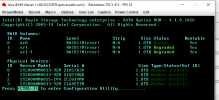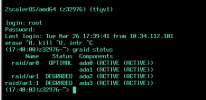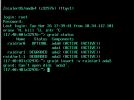I have an old Supermicro server X9DRW using Intel Rapid Storage to create a RAID 1 running FreeBSD 13. One of the drives failed so I replaced it but the RAID isn't rebuilding and I can't seem to find a non destructive way to repair it.
Going into the Intel firmware menu at boot only gives me the options to create/destroy a RAID but both options clearly say all data will be lost if I do anything. I've looked into gmirror but it doesn't seem to read the disk information properly. The last option appears to be graid but I can't get it to rebuild it.
Any help would be much appreciated
Going into the Intel firmware menu at boot only gives me the options to create/destroy a RAID but both options clearly say all data will be lost if I do anything. I've looked into gmirror but it doesn't seem to read the disk information properly. The last option appears to be graid but I can't get it to rebuild it.
Any help would be much appreciated




